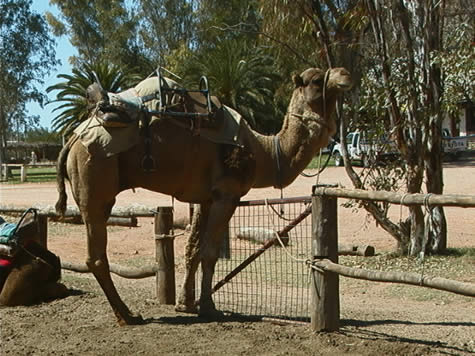2001 August 19, Sunday. Mount Isa.
Dromedaries (one-humped camels) were originally brought here from Arabia, the first major group being introduced specifically for the Burke and Wills expedition. By the late 1860s they were being imported in large numbers, and were used to carry supplies into arid regions. Mail and provisions reached Alice Springs, and other remote stations and communities, by camel strings. When the telegraph line was constructed from Adelaide to Darwin, dromedaries were used to transport the pylons needed. People from western Asia, broadly referred to as Afghans, were brought to manage the animals.
As settlement advanced, and road and rail transport reached the outback, people no longer required their camels, and released them to fend for themselves. The Arabian camels were well suited to the desolate environment, so similar to their native Sahara, and have thrived ever since.

Today, up to 100 000 feral camels roam the desert regions of Australia, the only country in the world which is inhabited by wild dromedaries. They are soft-footed herbivores, do not directly threaten native animals, and therefore have less impact on their environment than most feral species.
Dromedaries have also become a point of interest for tourists, and camel farms have emerged to supply animals for tour companies, racing, live export, three abattoirs in Alice Springs, and wool production. Camel milk can last for six months without refrigeration or preservatives. Unlike the warm furry coats of most animals, the dromedary’s thick hair provides insulation against the sun’s heat.
They are a low maintenance herd, able to extract nourishment from the hardest and driest of desert vegetation, and capable of surviving for long periods without drinking. During the 1870s, the explorer Ernest Giles, who led expeditions into the scorching desert region to the south west of Alice Springs, travelled 354 kilometres in eight days, without watering his fully laden beasts. In 1891, another camel expedition travelled more than eight hundred kilometres in one month.
Dromedaries have adapted amazingly to what is to human beings a barren and hostile land. What other animals can you think of which have adapted similarly to life in a desert? What animals have adapted well to other environments, which are inhospitable to us? Think about ice, jungle, or the ocean. What happens when an animal is taken from an environment to which it has adapted? Think about why different animals inhabit different parts of the earth.
bel